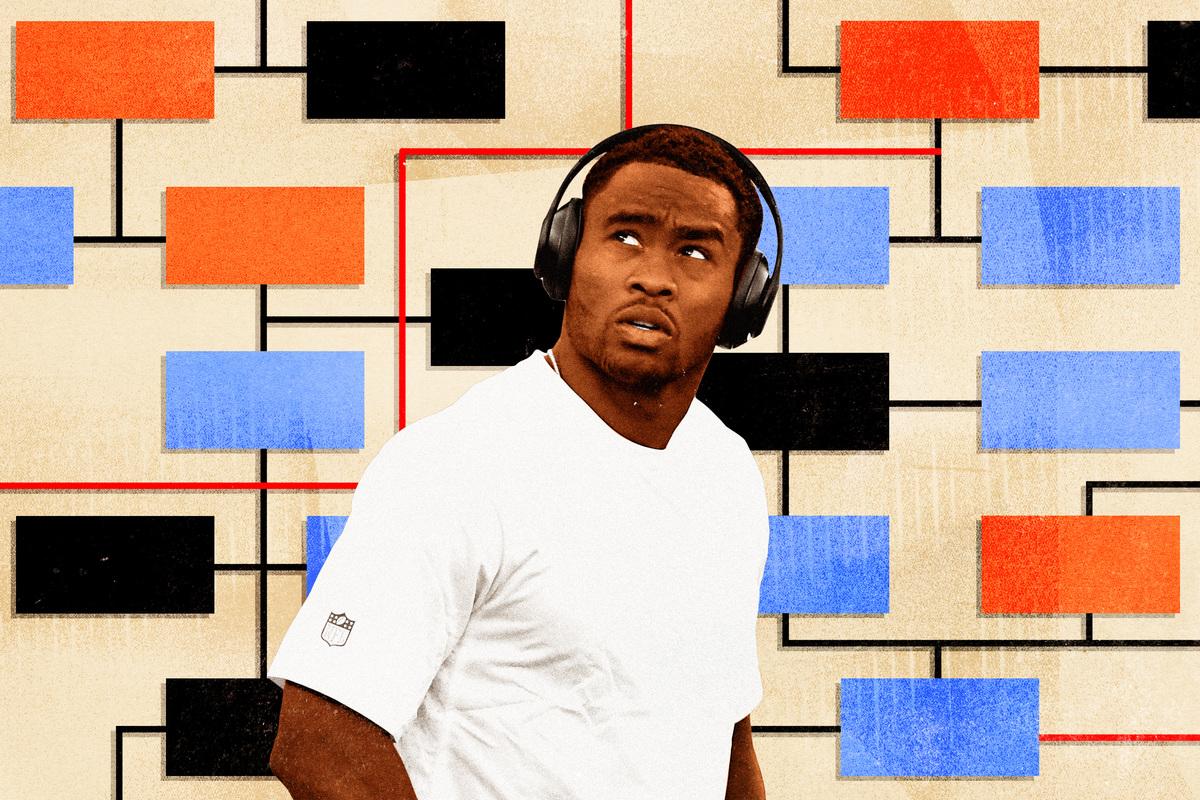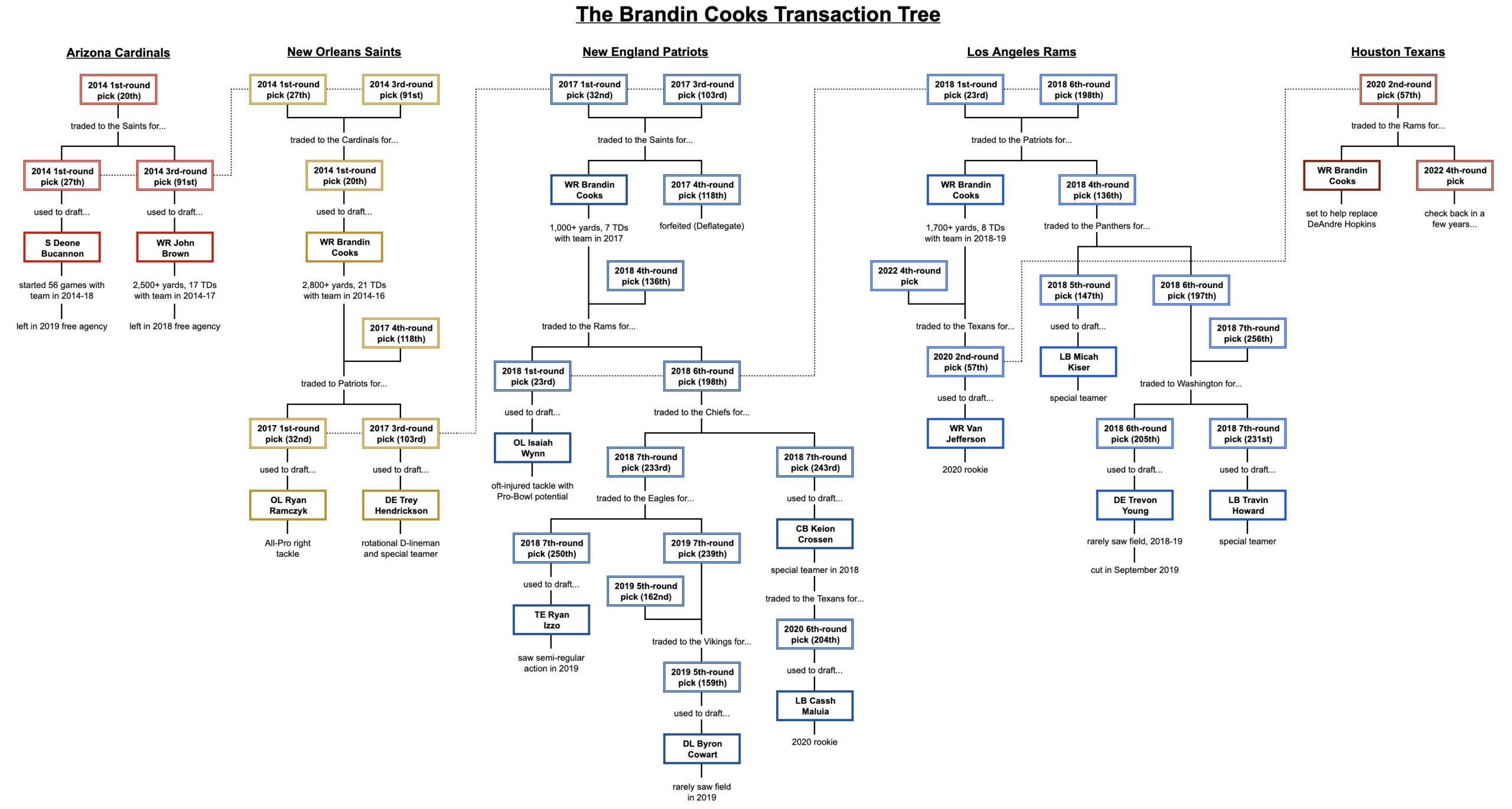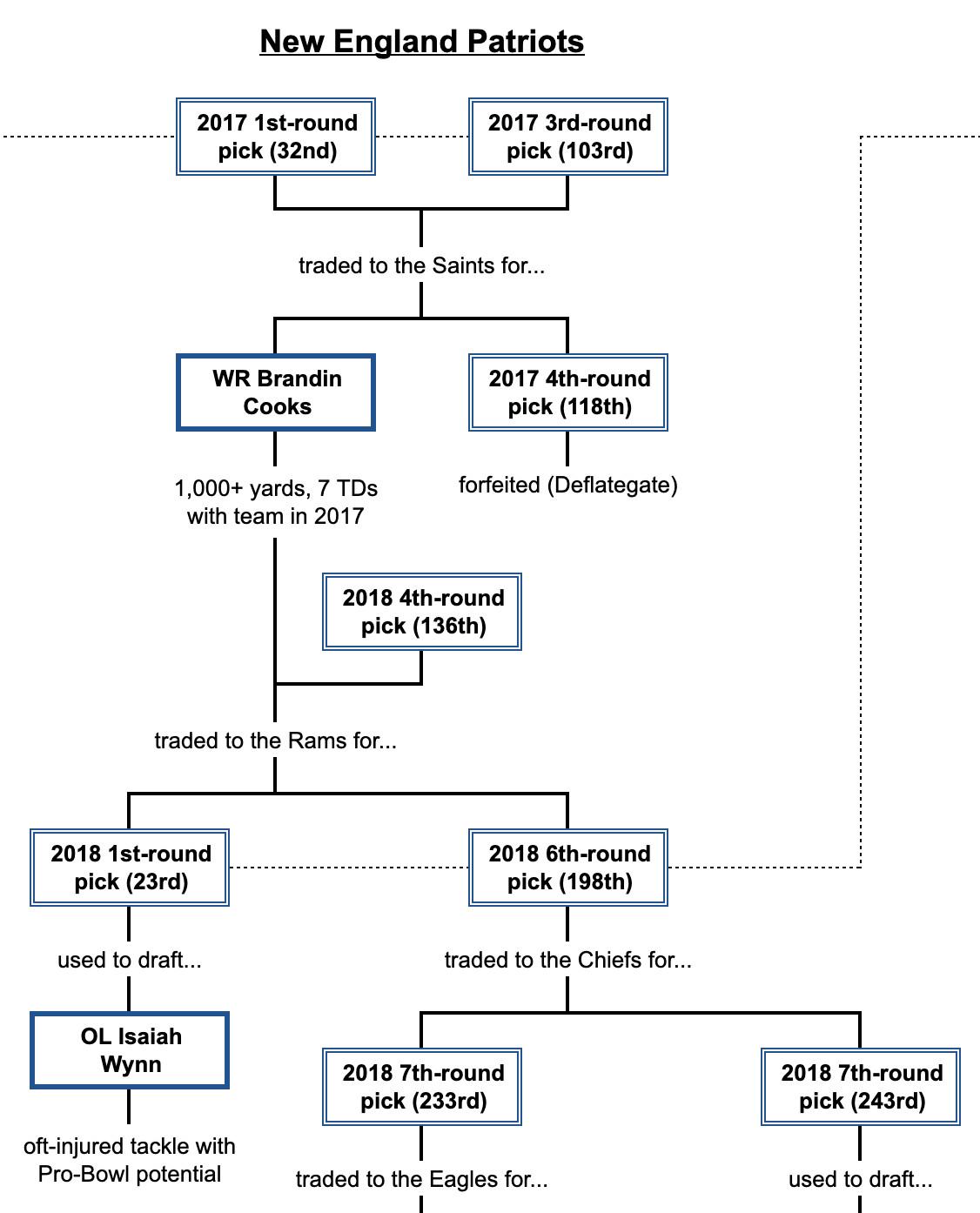What Brandin Cooks’s Transaction Tree Reveals About the Modern NFL
The Texans wideout has been traded three times in his career, resulting in a litany of picks and players making their way around the league. But these deals don’t just tell Cooks’s story—they also offer lessons about how smart teams build their rosters.
Brandin Cooks has been in the NFL for only six seasons, but a chart of his career path looks less like a “transaction tree” than it does a transaction forest. Take a look:

Cooks has been traded three times, and the assets teams have gotten in return are nearly a quarter of an NFL roster. The graphic above includes 21 draft picks, 13 players, and five different NFL franchises. While all those assets don’t necessarily have direct ties to Cooks, no NFL player in recent memory has had a career that even vaguely resembles his. Cooks is a solid receiver, always on the verge of the Pro Bowl, but he’s never quite cracked into the league’s elite tier of wideouts. He’s a luxury asset for win-now teams, but has never gotten a true long-term commitment from any franchise.
Every deal Cooks has been involved in (including the 2014 draft-day trade that netted the Saints the no. 20 pick and eventually Cooks) tells a story not only about the wide receiver, but about the league at large. They show how some of the smartest teams have built their rosters over the past six seasons—and how single decisions can reverberate for years to come. To understand Cooks’s career is to understand the NFL. Let’s break down some of the lessons:
The Art of Going All In
In 2014, the Saints needed another playmaker on offense. They were coming off an 11-5 season in which the team’s leading pass catchers were Jimmy Graham and Marques Colston. Drew Brees was entering his mid-30s, and the Saints saw an opportunity to give their future Hall of Fame passer a field-stretching playmaker in Cooks. So they sent picks 27 and 91 to Arizona in exchange for no. 20. Based on the AV draft value chart, that trade was like swapping 125 cents for a dollar—i.e., a huge loss for the Saints—but New Orleans wasn’t going to get a Cooks-level talent anywhere else.
The Cardinals, meanwhile, were coming off a 10-6 season of their own, but didn’t have the need for a player like Cooks. Just two years earlier, they had drafted wideout Michael Floyd with the no. 13 pick. The immediate payoffs for both franchises were mixed. The Cardinals netted two solid players—Deone Bucannon and John Brown—with the picks they got from the Saints, and went 11-5 in 2014 and 13-3 in 2015. And while Cooks was a decent contributor in New Orleans, the Saints went 7-9 in each of their next three seasons.
Cooks’s transaction tree is littered with teams that felt they were just one piece away from a run—and those situations didn’t always turn out the way the Saints-Cardinals swap did. Three years later, when the Patriots traded for Cooks, he helped lift their offense (the team jumped from second to first in DVOA) and guided them to a second straight Super Bowl appearance.
When the Rams traded for him in 2018, L.A. jumped from sixth to second in DVOA and also made a Super Bowl run. All that success—and an uncanny trend of falling just short of a Lombardi Trophy—isn’t solely due to Cooks, of course. But the wide receiver has been a perfect avatar for the type of player teams seek out when they’re trying to take an already good offense to the next level. Why is that? It all has to do with his primary skill: speed.
The Importance of Speed
In the NFL, speed is king. The Chiefs just won the Super Bowl thanks in part to one of the fastest groups of receivers ever seen. And even teams without Kansas City’s corps need take-the-top-off-the-defense receivers.
When the Saints drafted Cooks, the team had plenty of offensive playmakers, but no wideout who could stretch the field. So it made sense for them to trade up for Cooks, who had recorded a 4.33 40-yard dash time at that year’s combine, the fastest time among all position groups. After the Saints moved on from Cooks, they signed Ted Ginn Jr. to fill that outside role. This season, they’re bringing in Emmanuel Sanders.
The Patriots did something similar. In 2016, their leading receivers were Julian Edelman, Martellus Bennett, Chris Hogan, and James White—not exactly burners. They brought in Cooks, and Tom Brady’s deep-passing rate jumped from 11.3 percent (22nd) to 13.8 (eighth), according to Pro Football Focus. After the Patriots offloaded Cooks, they took fliers on Cordarrelle Patterson and Josh Gordon in attempts to fill his shoes.
Meanwhile in 2018, the Rams needed a Sammy Watkins replacement. Robert Woods and Cooper Kupp are plenty capable of attacking the middle of the field, but just one season after giving up a second-round pick for Watkins, the team sent a first-rounder to New England for Cooks. After trading away Cooks this season, the Rams don’t have an obvious speedster on their offense—and how Sean McVay schemes around that will be something to keep an eye on in 2020.
No franchise better represents the importance of speed than Cooks’s current team, the Texans. When Houston had Will Fuller on the field last season, its offense averaged 6.08 yards per play. Without him, that average dropped to just 5.29. Deshaun Watson’s QBR, yards per attempt, and sack rate were all significantly better with Fuller on the field. And the Texans converted a whopping 51.9 percent of third downs with Fuller out there—but just 32.9 percent without him. DeAndre Hopkins can do more than Fuller on the field—and has a claim as the best receiver in football—but the Texans offense is crippled when it doesn’t have a deep-play component. Fuller has missed 20 games in the past three seasons, and his injury issues may have contributed to the team’s trade for Cooks.
Speed is important, and the NFL knows it. It’s why burner receivers like Marquise Brown and Henry Ruggs have been selected in the first round of the NFL draft in recent seasons. The question now is whether that element of an offense needs to be filled with a first-round pick or a highly paid wideout, or whether a much lower-profile speedster will do. Based on how Cooks’s career has played out, several NFL teams have found their answer.
The Value of a Rookie Contract
Cooks’s roller-coaster career makes a bit more sense when you see how his cap hits have broken down by season:
- 2014 (Saints): $1.5 million
- 2015 (Saints): $1.9 million
- 2016 (Saints): $2.3 million
- 2017 (Patriots): $1.6 million
- 2018 (Rams): $5.4 million
- 2019 (Rams): $15.3 million
- 2020 (Texans): $8.0 million
- 2021 (Texans): $12.0 million
- 2022 (Texans): $13.0 million
- 2023 (Texans): $14.0 million
The Saints and Patriots—and every other team in the league—knew that a salary cap explosion was coming. Two very smart NFL teams saw Cooks’s talent and decided he was worth trading first-round picks to get. Then both teams saw what he did on the field and decided that, actually, they didn’t want to hand him the large contract he was sure to demand.
The Rams knew this was coming too, of course, but their all-in strategy warranted the risk. It almost worked too, until the L.A. offense nearly laid an egg in the Super Bowl against the very team that had traded Cooks away. Less than two years later, the Rams are eating a record $21.8 million in dead cap space just to send him to the Texans.
The Texans, meanwhile, are also taking a risk. They’ll be taking big cap hits to roster Cooks when they could have used that second-rounder to draft a wideout in a deep receiving class. It’s fair to point out that the team probably could have done better.
The Randomness of the Draft
No team can consistently win at the draft. The smartest general managers know this, so they try to maximize their value not by picking the best players, but by getting as many high-quality picks as they can. In that sense, the Patriots had the best process with Cooks, even if they didn’t get the best results.
It’s no surprise that New England’s transaction tree is the largest of the bunch here. Bill Belichick loves to find value in trades, and he essentially turned two draft picks into Brandin Cooks (and another pick), and then turned Cooks into four players who are still on the Pats’ roster.
Just look at the beginning of the tree to see how smart Belichick is:

The first “branch” of the tree shows that between the picks Belichick traded out (32, 103, and 136) and the ones he brought in (118, 23, and 198), he made back about 94 percent of the value of the original selections. Plus he got one year of Cooks. The forfeiture of the fourth-round pick and the subsequent disappointing performances of the players the Patriots added with the other picks puts a damper on this line of transactions, but the process employed here is masterful. Belichick essentially rented a talented wideout for a season for free. (The later swaps of fifth-through-seventh-rounders amount to the trading of pocket change and aren’t too consequential.)
The draft is random; no one team consistently scouts better than others. But there is value to be found in the right trades, and no one is better at homing in on that than Belichick.
How Transactions Reverberate for Years
The team that has “won” the Brandin Cooks carousel isn’t up for debate—it’s the Saints. While New Orleans may have paid a premium in 2014 to move up to get Cooks, that deal paid massive dividends. The Saints had Cooks for three years when the receiver was on a below-market rookie deal, then dealt him to the Patriots for a 2017 first-round pick and a 2017 third-rounder. They used that pick to draft Ryan Ramczyk, who is now one of the best offensive linemen in the league.
Ramczyk allowed just one sack, one hit, and 21 total pressures last year, per Pro Football Focus. He committed just six penalties, and overall was the third-highest-graded offensive lineman in the league, earning first-team All-Pro honors. In 2018, he was PFF’s 10th-highest-graded lineman, and in 2017—his rookie season—he ranked 18th. He’s 26 years old and is on the fast track to becoming a household name. Virtually the only question mark around Ramczyk is how the Saints will pay him when his rookie deal runs out after the 2021 season, as the most aggressive franchise in football navigates a high-wire act that is complicated by COVID.
The other squads on this list haven’t been as lucky. The Cardinals turned Cooks—or at least, the 21st pick in the 2014 draft—into two players who put in a solid few seasons with the squad before leaving in free agency. Would they have rather had Cooks? It’s difficult to say. In a vacuum, a few years of Cooks seems roughly equivalent to a few years of Bucannon and Brown. But if they’d had Cooks, they also may have been able to trade him for better assets like the Saints did.
The Patriots also weren’t very lucky. Though Isaiah Wynn could still turn out to be a solid NFL player, the collection of special teamers and practice-squad guys also on the chart doesn’t inspire much confidence. But then again, as detailed above, the Pats basically rented Cooks for free. I don’t think they can be unhappy about the 1,000-plus-yard season and Super Bowl appearance they got with him on the roster.
The Rams are also tricky. They, too, got a Super Bowl appearance with Cooks on the field, and it’s unlikely McVay’s offense would have worked as well as it did in 2018 without the deep-play talent Cooks provided. The Rams used the second-round pick they got in that trade to draft a wide receiver, Florida’s Van Jefferson, who is very much not a Cooks replacement. Rather than being a speedster, Jefferson is a possession wideout. Ringer draft expert Danny Kelly compared Jefferson to Cooper Kupp. Whether the Rams’ Cooks experience—the trade to get him, the big contract extension, and the trade that sent him away—should be considered a win or a loss for the franchise could depend on how Jefferson plays in Los Angeles, especially with the aforementioned cap hit eating into the team’s flexibility.
And the Texans are still pretty much TBD. It’s difficult to decouple their Cooks trade from their move to send DeAndre Hopkins to Arizona—and from Bill O’Brien’s reputation more generally—but in a vacuum, the Cooks deal wasn’t too bad: They got Cooks and a fourth-round pick in exchange for a second-rounder. Sure, they’re paying more for Cooks than they probably should, and his skills may be redundant next to Will Fuller. But their return on investment isn’t necessarily final—in a few years, the Texans may have traded Cooks and gotten far more value in that deal. If recent history is any indication, the Brandin Cooks transaction tree will only keep growing.

